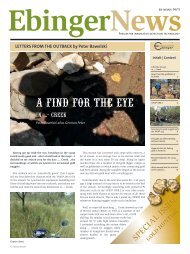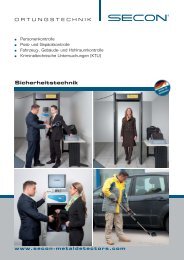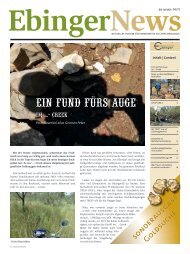unterwasser-metalldetektoren uwex® erobern den tauchsport - Secon
unterwasser-metalldetektoren uwex® erobern den tauchsport - Secon
unterwasser-metalldetektoren uwex® erobern den tauchsport - Secon
Sie wollen auch ein ePaper? Erhöhen Sie die Reichweite Ihrer Titel.
YUMPU macht aus Druck-PDFs automatisch weboptimierte ePaper, die Google liebt.
FIELD TEST OF METAL DETECTOR TREX® 204 M<br />
Dzafer Kumbara<br />
The new metal detector TREX ® 204 M was tested from<br />
the middle of April by local EOD (explosive ordnance<br />
disposal) officers in Orasje, Bosnia. The following results<br />
became available at the end of June:<br />
First of all it was investigated whether the detector<br />
would meet the requirements of humanitarian land<br />
mine detection. The UPMAH-3 was used as reference<br />
object. This was buried in a test bed and had to be<br />
detected at various depths and with commonly used<br />
probe detection speeds over the ground.<br />
Depth Detection speed Indication<br />
10 cm 0.3 m / Sec. yes<br />
13 cm 30 cm / Sec. yes<br />
16 cm 30 cm / Sec. yes<br />
Satisfactory test results were achieved with medium<br />
detector settings in respect of mineralized ground and<br />
the sensitivity.<br />
The detector was then used every day by 16 different<br />
EOD officers. The conclusive impression was good.<br />
The convincing features were:<br />
That it was lightweight, that the location of detected<br />
objects could be determined precisely and that the device<br />
could be operated very fast and easily. The search<br />
coil, which looks like a hockey stick, is perfectly suited<br />
for use in <strong>den</strong>se vegetation and high grass, among<br />
rocks and under undergrowth. It provides the safety<br />
necessary for EOD officers to progress their work rapidly<br />
and easily.<br />
When used on the damaged parts of buildings, holding<br />
the detector head into the cracks before removing<br />
rubble also helps to ensure the EOD officers‘<br />
safety when working. The alarm signal helps in differentiating<br />
between large and small objects and whether<br />
these are at low or great depths.<br />
The inspector (supervisor) found that the productivity<br />
with the TREX ® 204 M was 11 m 2 in half an hour. This<br />
is equivalent to a performance of 110 m2 per day. No<br />
other detector could reach this level of performance!<br />
The detector does not work when used close to electricity<br />
cables buried in the ground. This is indicated<br />
by a continuous alarm signal with several stops. On<br />
the other hand the device functions in a proper and<br />
undisrupted manner when used near high-tension<br />
(power) lines with high discharges. A total of 21 antipersonnel<br />
mine fuses could be detected in a very precise<br />
and reliable manner on 11.05.2010. Additional<br />
fuses of the same type have been detected at a depth<br />
of 15 cm under vegetation.<br />
On the following day we detected further fuses in the<br />
beds of bombed greenhouses with the same level of<br />
safety.<br />
14| ebingernews<br />
It has to be noted that mineral fertilizers had been used in the past and this had led<br />
to the ground being highly mineralized. The TREX ® 204 M was not affected by this.<br />
On 17.05.2010 it was operated with modified ground compensation settings on a<br />
non-cooperative mineralized ground.<br />
The conclusion of our EOD organisation is: All safety requirement and work quality<br />
parameters were met by the use of TREX ® 204 M in the mine field. The slim hockey<br />
probe offers a lot of advantages when used under <strong>den</strong>se vegetation. The speed at<br />
which small and large objects can be detected and their position indicated as well<br />
as the depths at which detection can be achieved are satisfactory. In contrast to<br />
other detectors pinpointing was possible. The alarm signal enhances productivity<br />
and helps to avoid crucial failures.<br />
TREX® 204 M on highly mineralized non-cooperative ground<br />
The detector has been tested in Herzegowina at the Suva Smokva Nr. 8 location,<br />
which is part of the organisation N&N Ivsa from Orasje. After the pre-inspection of<br />
the field by another modern detector, the TREX ® 204 Mwas used for quality control.<br />
The test results obtained were as follows:<br />
The test took place on 18.06.2010 starting 6 a.m. The humidity was very high and<br />
the temperature was around 18°C. The test started with the examination of a fuse<br />
whose holder was located 40 cm above the ground. The pre-inspection included:<br />
- active detection of fuses at a depth of 10 cm (13 and 15 cm) with a speed of 0.3 m<br />
per second with elevated head<br />
The next detection field included the examination of buried fuses. In this case a<br />
continuous alarm was obtained with a medium sensitivity and ground compensation<br />
setting. Accordingly the settings for sensitivity and ground compensation were<br />
adjusted until the ground interference was suppressed.<br />
It has to be noted that for this the detector had to be switched off and then on again.<br />
This meant that detector adjustment took around 30 to 45 sec.








